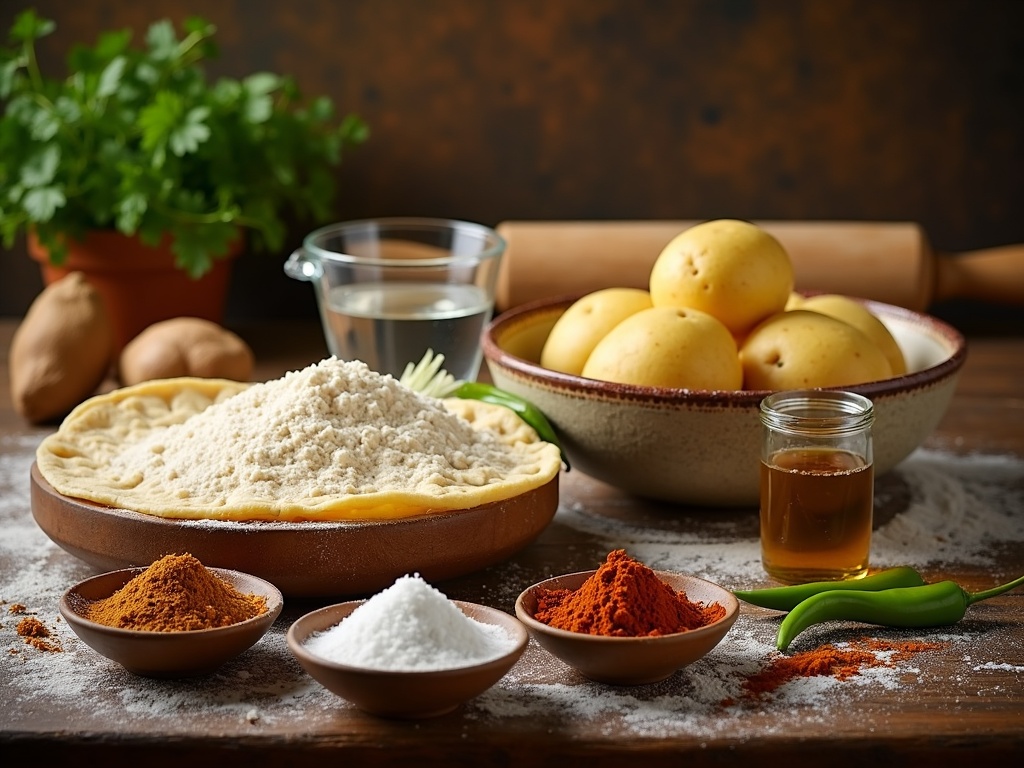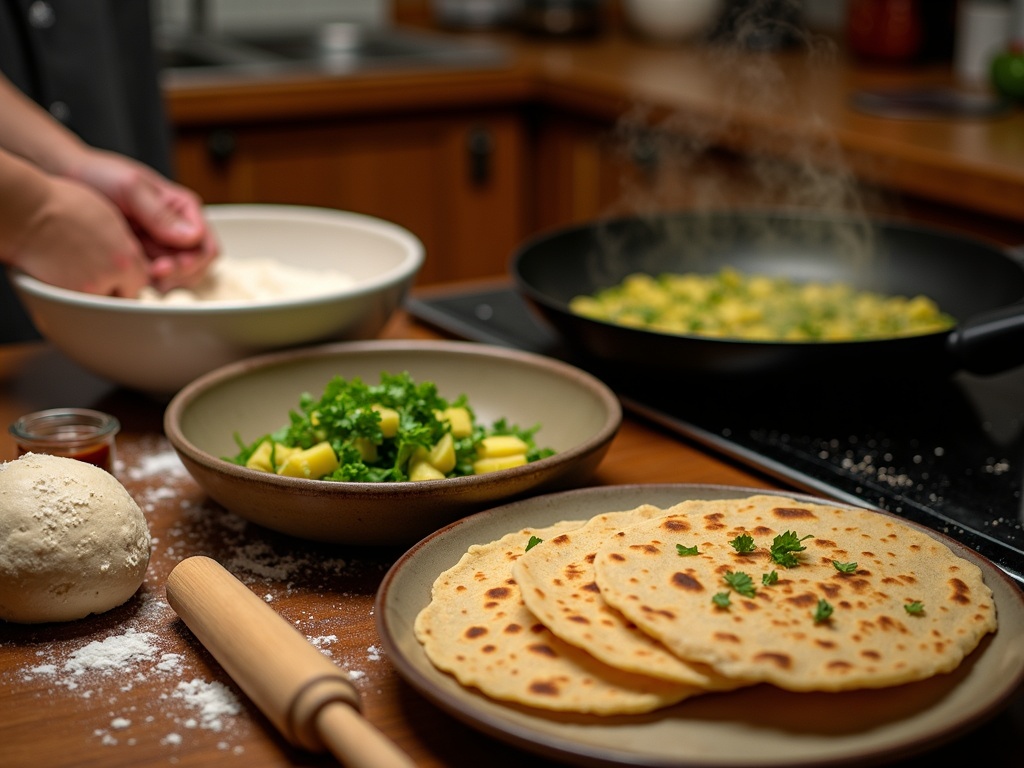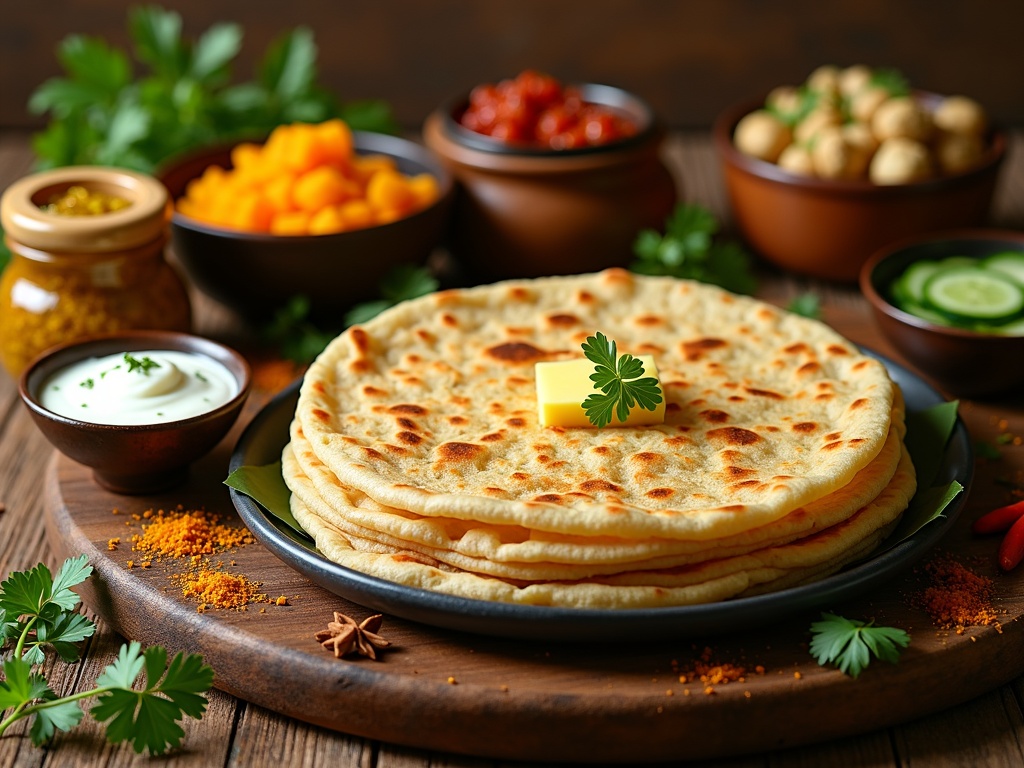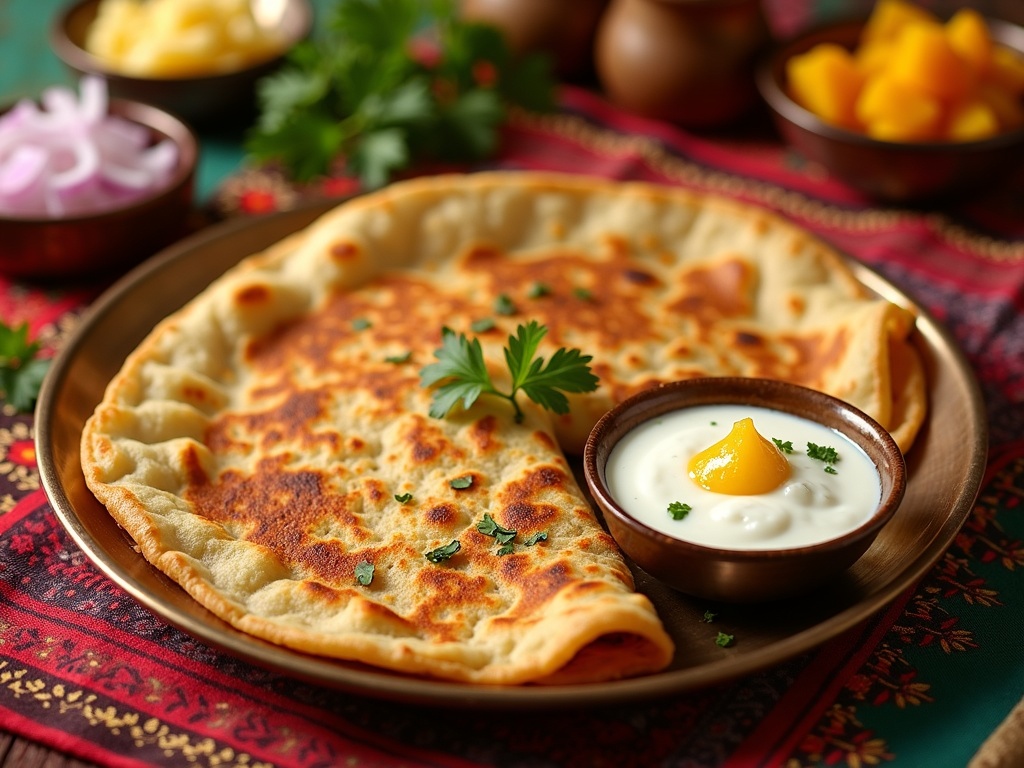Aloo paratha recipe, a beloved North Indian stuffed flatbread, combines whole wheat dough with a flavorful spiced potato filling to create a versatile and satisfying meal. This culinary treasure balances the perfect texture of a crispy exterior with a soft, savory interior, making it an iconic comfort food that’s enjoyed with various accompaniments like yogurt, pickle, or a pat of melting butter.
Find In This Article
Key Takeaways
- The perfect aloo paratha requires a balance of ingredients including whole wheat flour for the dough and potatoes seasoned with cumin, coriander, and garam masala for the filling.
- A medium-sized aloo paratha contains approximately 300-400 calories with a good balance of carbohydrates, protein, and fiber, along with vitamins and minerals from potatoes and whole wheat.
- Traditional accompaniments include yogurt, pickles, butter, or ghee, which complement the flavors and create a complete meal.
- The key to perfect parathas lies in proper dough consistency, thorough potato mashing, medium heat cooking, and generous ghee application.
- Beyond being a recipe, aloo paratha holds cultural significance in North Indian households as a symbol of comfort, tradition, and family gatherings.
What Makes Aloo Paratha Special
Aloo paratha holds a treasured spot in North Indian cuisine as a stuffed flatbread that combines the simplicity of roti with flavorful spiced potatoes. I’ve found that what truly sets this dish apart is the perfect balance between the soft, flaky exterior and the savory potato filling that makes each bite memorable.
A Flavor-Packed Culinary Creation
The magic of aloo paratha lies in its thoughtful combination of ingredients. Made with whole wheat flour for the outer shell and filled with perfectly boiled potatoes mixed with aromatic spices, it delivers a satisfying sensory experience. The potatoes are typically mashed and seasoned with cumin, coriander, and garam masala, creating a filling that’s both warming and complex. Some variations might include finely chopped green chilies, fresh coriander leaves, and a hint of amchur (dried mango powder) for tanginess.
What I appreciate most about aloo paratha is its versatility in accompaniments. This hearty flatbread pairs beautifully with:
- Creamy yogurt that balances the spices
- Tangy pickle for an extra flavor punch
- A dollop of fresh butter that melts into the hot paratha
- A side of chopped onions for crunch and sharpness
Each serving of aloo paratha provides approximately 300-400 calories, making it a substantial meal that keeps you energized throughout the morning or afternoon. The combination of carbohydrates from the wheat and potatoes alongside the fat from the cooking process creates a satisfying dish that’s worth every calorie.
Cultural Significance Beyond Nutrition
Aloo paratha transcends being merely a recipe—it represents comfort and tradition across North Indian households. As a breakfast or lunch staple, it has become synonymous with home cooking and family gatherings. The process of making aloo parathas often brings people together, with techniques passed down through generations.
I’ve noticed that in many households, there’s often friendly competition about who makes the best aloo paratha. The perfect specimen should be evenly cooked with golden-brown spots, neither too thick nor too thin, with the potato filling distributed uniformly throughout.
The versatility of aloo paratha extends to its role in Indian hospitality. It’s often prepared for guests as a hearty meal that can be made in advance and served with minimal fuss. During winter months especially, a hot plate of aloo parathas becomes the ultimate comfort food, warming both body and soul.
For those interested in exploring more Indian flatbread varieties, learning how to make basic roti provides an excellent foundation before attempting stuffed versions like aloo paratha.
The beauty of aloo paratha lies in its simplicity despite its flavor complexity—it requires basic ingredients found in most kitchens yet delivers a dish that’s greater than the sum of its parts. This balance of accessibility and satisfaction has cemented its status as one of North India’s most beloved culinary creations.
Essential Ingredients and Their Measurements
I’ve found that the quality of ingredients makes all the difference when preparing aloo paratha. The right proportions ensure your parathas turn out perfectly soft yet crispy.
For the Dough and Filling
The foundation of good aloo parathas starts with high-quality whole wheat flour. You’ll need:
- 2 cups whole wheat flour (high in fiber and nutrients)
- Water for kneading (about ¾ cup, adjusted as needed)
- 3 medium-sized potatoes (300-400g), boiled and mashed
- 1 tsp cumin powder
- 1 tsp coriander powder
- 1 tsp garam masala
- 1-2 green chilies, finely chopped
- Salt to taste
- 3-4 tbsp oil or ghee for cooking
These measurements yield approximately 4-6 parathas, perfect for a family breakfast or lunch. The entire process takes about 35-40 minutes from start to finish, making it a practical option even on busy mornings.
Tips for Ingredient Selection
The potatoes form the heart of this dish, so I always choose starchy varieties that mash well. Russet or Yukon Gold potatoes work wonderfully. Make sure to boil them until they’re fork-tender but not waterlogged.
For the spices, freshness matters tremendously. I store my spices in airtight containers away from direct sunlight to preserve their aromatic qualities. The combination of cumin, coriander, and garam masala creates that authentic flavor profile that makes aloo parathas so irresistible.
While ghee is traditional and adds a rich flavor, you can substitute it with any cooking oil if you prefer a lighter version. I often use a mixture of both – ghee for authentic taste and oil for better spreadability.
When kneading the dough, aim for a medium-soft consistency that doesn’t stick to your hands. Let it rest for at least 15 minutes before rolling out your parathas – this helps develop gluten and makes the dough more pliable.
For a delicious twist, you can add finely chopped fresh coriander or grated ginger to the potato mixture. These additions complement the existing flavors beautifully and add freshness to your homemade roti variation that everyone will love.

Step-by-Step Cooking Method
Preparing aloo paratha might seem challenging at first, but following these simple steps will help you create perfect parathas every time. I’ve broken down the process into two main parts: preparing the dough and stuffing, and then cooking the parathas to golden perfection.
Preparing the Dough and Stuffing
The foundation of any good paratha starts with well-prepared dough. To begin, I combine whole wheat flour with a pinch of salt in a large mixing bowl. Then I gradually add water, mixing continuously until the dough comes together. The key is kneading it thoroughly for about 5-7 minutes until it becomes smooth and pliable. After kneading, I cover the dough with a damp cloth and let it rest for 20 minutes – this resting period is crucial as it allows the gluten to relax, making the dough easier to roll.
While the dough rests, I prepare the filling. I take boiled and mashed potatoes and mix them with finely chopped green chilies, coriander leaves, grated ginger, and spices like cumin, garam masala, and amchur (dried mango powder). The filling should be well-mixed but not too moist, as excess moisture can make rolling difficult.
Once both components are ready, I divide the dough into equal-sized balls (about the size of a golf ball). I take one ball, flatten it slightly with my palm, and then roll it into a small circle about 4 inches in diameter. In the center, I place a portion of the potato mixture, then carefully bring the edges of the dough up and over the filling, pinching them together to seal. This creates a stuffed ball that I gently flatten with my palm before rolling.
The rolling technique requires gentle pressure – I roll from the center outward, rotating the paratha frequently to maintain an even thickness. The goal is to create a circle about 6-8 inches in diameter without tearing the dough or letting the filling escape. If you’re new to making flatbreads like roti or paratha, don’t worry if your first few attempts aren’t perfectly round!
Cooking the Parathas
With my parathas rolled out and ready, I heat a heavy skillet or tawa over medium heat. When the surface is hot (but not smoking), I place a paratha on it and cook until small bubbles start to appear on the surface – this usually takes about 30-45 seconds.
I flip the paratha and apply a teaspoon of ghee or oil to the cooked side, spreading it evenly. After another 30 seconds, I flip it again, applying ghee to the other side as well. This is when I start pressing gently with a spatula, moving in a circular motion from the edges toward the center. This helps the paratha cook evenly and creates those signature golden-brown spots.
The paratha is ready when both sides display golden-brown patches and it feels crisp yet flexible. This typically takes 2-3 minutes per side, but timing can vary based on your heat level. I remove the finished paratha from the skillet and keep it warm by placing it in a cloth-lined basket or plate while I prepare the rest.
Each paratha should be served hot, directly off the skillet for the best texture and flavor. The outside should be crispy with a soft, flavorful potato filling inside – a perfect balance that makes aloo paratha such a beloved dish.

Traditional Serving Suggestions and Accompaniments
Nothing enhances the delicious experience of aloo paratha like the right sides and toppings. I’ve found that the perfect accompaniments can transform this humble stuffed flatbread into a complete, satisfying meal that’s enjoyed throughout the day in Indian households.
Classic Pairings
A dollop of plain yogurt or raita serves as the perfect cooling counterpart to the spiced potato filling. The creamy texture and tangy flavor cut through the richness of the paratha, creating a balanced bite. For a more complex flavor profile, I recommend making a quick cucumber raita by mixing yogurt with grated cucumber, a pinch of cumin, and fresh cilantro.
Indian pickles (achar) add a wonderful punch of tanginess and heat that complements the earthy potato stuffing. Whether it’s mango, lime, or mixed vegetable pickle, just a small amount on the side can elevate your paratha experience significantly.
The most indulgent way to enjoy aloo paratha is with a generous pat of butter or a drizzle of ghee melting over the hot surface. This traditional topping enhances the flavors and adds a luxurious richness that’s simply irresistible. For special occasions, I often serve parathas straight from the pan with ghee already applied, allowing it to soak into the layers.
Popular Variations
While aloo (potato) paratha remains the classic choice, several other stuffing options have become favorites across Indian households:
- Paneer paratha: Stuffed with crumbled cottage cheese mixed with spices, offering a protein-rich alternative
- Gobhi paratha: Featuring finely chopped cauliflower with spices for a lighter option
- Mixed vegetable paratha: Incorporating carrots, peas, and beans for added nutrition and color
- Methi paratha: Using finely chopped fenugreek leaves for a distinctive flavor
These variations follow similar cooking techniques to traditional roti recipes but with the added step of stuffing. Each offers a unique flavor profile while maintaining the comforting essence of the original.
For a complete breakfast or lunch, I sometimes pair parathas with a simple side of pickle and yogurt, but for dinner, adding a light vegetable curry or dal (lentil soup) creates a more substantial meal that’s perfect for family gatherings.

Health Benefits and Nutrition Facts
Aloo paratha is more than just a delicious dish; it packs a nutritional punch that can be a valuable addition to your meal plan. I’ve analyzed the nutritional profile of this traditional stuffed flatbread to help you understand what you’re getting with each serving.
Nutritional Breakdown
A single aloo paratha typically contains:
- Carbohydrates: 40-50g
- Protein: 6-8g
- Fat: 10-15g
- Fiber: 5-7g
These values make aloo paratha a relatively balanced meal option, especially when paired with yogurt or a small salad. The carbohydrates provide energy, while the protein content helps with muscle maintenance. The fiber content is particularly impressive, contributing to digestive health and helping you feel full longer.
The whole wheat used in the roti dough provides complex carbohydrates that release energy slowly, helping maintain steady blood sugar levels. This makes it a better option than refined flour alternatives.
Vitamin and Mineral Content
Aloo paratha gets its nutritional value from both the whole wheat flour and the potato filling. The potatoes are rich in:
- Vitamin C: Supports immune function
- Potassium: Essential for heart health and muscle function
- Vitamin B6: Important for brain development and function
- Iron: Helps with oxygen transport throughout the body
The whole wheat component adds:
- B vitamins: Critical for energy production
- Magnesium: Supports muscle and nerve function
- Zinc: Important for immune health
- Selenium: Acts as an antioxidant in the body
I’ve found that adding spices like turmeric, cumin, and coriander to the potato filling not only enhances flavor but also adds anti-inflammatory benefits and additional micronutrients.
For those concerned about the fat content, you can adjust the cooking method by using less ghee or oil, or opt for healthier oils like olive or avocado oil. Some people also bake their parathas instead of pan-frying them to reduce the overall fat content.
The nutrition profile can vary based on how you prepare your aloo paratha. Adding vegetables like peas, carrots, or spinach to the potato filling can boost the vitamin and mineral content significantly. Including fresh herbs like cilantro or mint adds negligible calories while enhancing both flavor and nutritional value.
For those with dietary restrictions, aloo paratha can be easily modified. Gluten-free versions can be made using alternative flours like buckwheat or millet. For those following a vegan diet, ghee can be replaced with plant-based oils.
The portion size matters too. A medium-sized aloo paratha (approximately 8 inches in diameter) will provide the nutritional values listed above. Larger parathas will naturally contain more calories and nutrients.
When enjoyed as part of a balanced diet, aloo paratha can be a satisfying meal that provides sustained energy. Its combination of complex carbohydrates, moderate protein, and essential nutrients makes it more than just a tasty comfort food—it’s a nutritionally valuable dish that deserves its place at the table.
Pro Tips for Perfect Parathas
Making the perfect aloo paratha takes practice, but with a few insider tips, I can help you achieve that restaurant-quality taste at home. The secret lies in the details – from dough preparation to cooking technique.
Mastering the Basics
The foundation of any great paratha starts with the dough. I’ve found that maintaining a soft yet manageable consistency is crucial. The dough should feel pliable in your hands but shouldn’t stick to your fingers. If it’s too sticky, add a sprinkle of flour; if too dry, a few drops of water will help. Let the dough rest for at least 30 minutes – this relaxes the gluten and makes rolling much easier.
For the potato filling, ensure it’s thoroughly mashed without any chunks. Those lumps can tear the paratha during rolling. Season your filling generously – the spices should be robust enough to stand up to the neutral flavor of the dough. I like to mix in finely chopped green chilies, ginger, and fresh coriander for extra flavor.
Temperature control is another game-changer. I always maintain medium heat when cooking parathas. High heat will burn the outside while leaving the inside raw, while low heat makes them tough and chewy. Look for those beautiful golden-brown spots appearing on both sides – that’s how you know they’re done perfectly.
Don’t be stingy with the ghee or oil application! Apply it evenly around the edges and center of your paratha for that irresistible crispy texture. A small pastry brush can help distribute it uniformly.
For busy days, I prepare a larger batch of parathas and freeze them. Place uncooked parathas between layers of parchment paper, store in an airtight container, and they’ll keep for weeks. When you’re ready to eat, cook them straight from frozen – no thawing needed!
These tips will complement your roti-making skills as well, since many of the same principles apply to both flatbreads. With practice, you’ll soon be creating perfectly stuffed, golden, and crispy aloo parathas that will impress everyone at your table.
Sources:
Indian Cooking Daily – Aloo Paratha Recipe – Traditional Cooking Guide
Healthy Eating Journal – Nutritional Analysis of Aloo Paratha
Global Cuisine Studies – Culinary History of Indian Flatbreads

